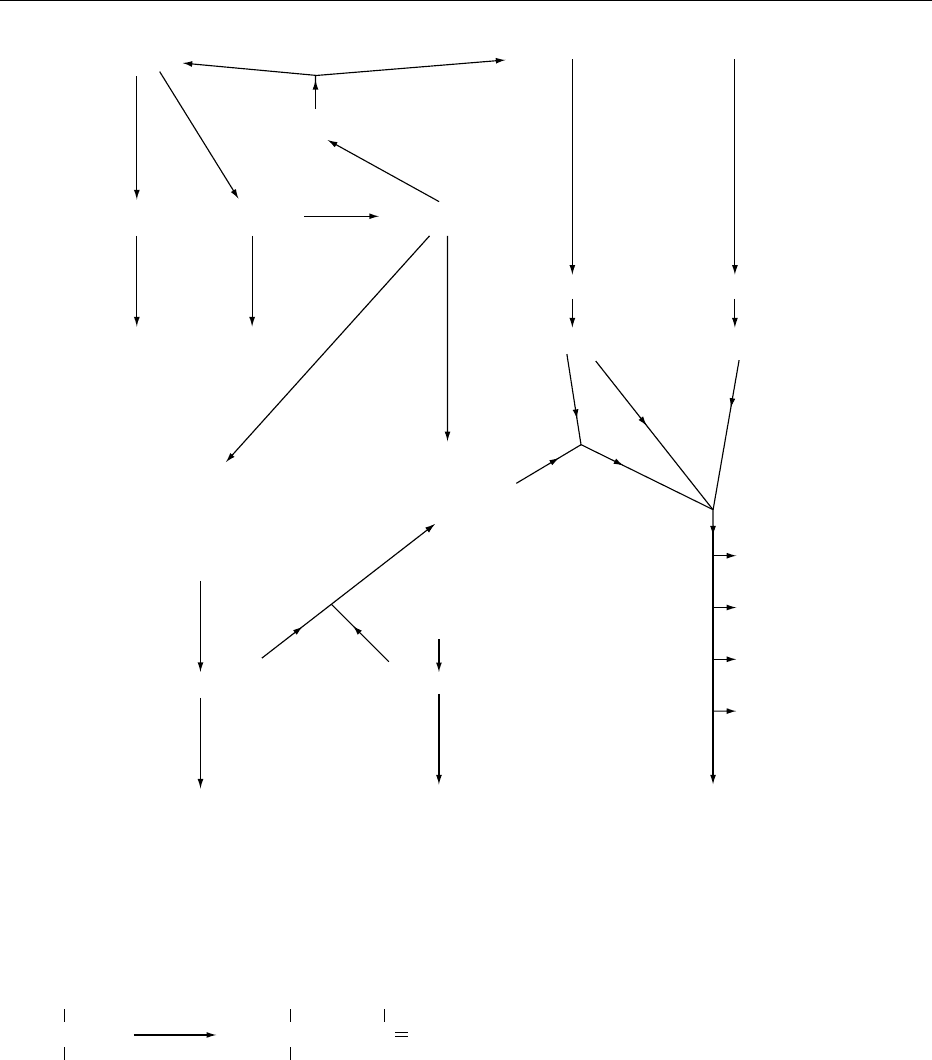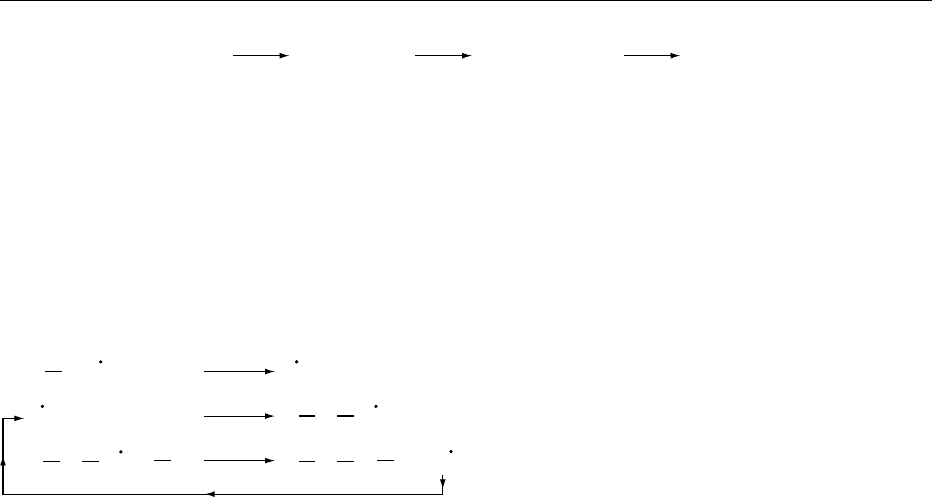Caballero B. (ed.) Encyclopaedia of Food Science, Food Technology and Nutrition. Ten-Volume Set
Подождите немного. Документ загружается.


The level of TMA produced can be used as an ‘index
of freshness,’ as the fish decays during storage on ice.
This illustrates how a volatile compound can be
classed as desirable, or as an off-odor, dependent on
its concentration.
Enzymatic and Chemical Degradation
Mechanisms
0018 The metabolic processes in plants and animals, which
are critical in relation to their storage stability after
harvesting or after slaughter, involve a complex series
of enzyme-catalyzed chemical reactions (i.e., bio-
chemical reactions). These lead to deterioration of
food quality, and the process is normally referred to
as autolysis (i.e., self-destruction). The endogenous
enzymes causing autolysis are an integral part of the
plant or animal food – and any treatment to affect the
enzyme activity cannot be done without the possibil-
ity of affecting the food itself.
0019 Enzymatic and chemical reactions overlap in the
sense that the enzyme speeds up the chemical reac-
tion, but to such an extent that the reaction rate is not
significant in the absence of the enzyme. A ‘chemical
catalyst,’ e.g., a transition metal ion such as copper,
iron, or nickel, can cause a large increase in the rate,
but the reaction will normally proceed at a measur-
ably rate in the absence of the ‘chemical catalyst.’
Thus, the oxidation in air of fish oils is catalyzed by
copper ions, but the oxidation still proceeds measur-
ably in the absence of copper ions. In contrast, the
hydrolysis of fish oil occurs readily at room tempera-
ture when catalyzed by the enzyme lipase, but in
the absence of lipase, the hydrolysis does not occur
significantly, not even at 100
C (at pH 7).
0020 Enzymes are complex proteins, and their catalytic
action is related to the shapes taken up by the protein
chains. This shape is held together mainly by numer-
ous weak hydrogen bonds, and these can be weakened
and changed by processes such as heating, freezing, or
changing the pH. The result is a loss of catalytic
activity by the enzyme; however, for endogenous
enzymes, the effect of such treatments on the organo-
leptic qualities of the food must be considered. More
specific methods of inhibiting enzyme activity include
the use of specific enzyme inhibitors such as sulfur
dioxide and bisulfites, the use of competitive sub-
strates, or chelation of metals necessary for the
activity of the enzyme.
0021 The undesirable effects of enzyme-catalyzed reac-
tions (i.e., autolysis) can be prevented in principle,
but often, the effect on the food’s organoleptic quality
may not be acceptable.
0022 The major chemical components of foods, i.e.,
lipids, proteins, and carbohydrates, can undergo
chemical changes, whether enzyme-catalyzed or
not, which can influence the safety, organoleptic
quality, or nutritional quality of the food. The
major reactions involved are oxidation and hydroly-
sis, at least initially, but more complex chemical
changes may occur subsequently. These can result
in the production of rancidity and browning (i.e.,
discoloration) which are often undesirable (see
Figure 1).
0023In general terms, the chemical changes can:
.
0024produce new compounds – possibly with undesir-
able toxic or organoleptic properties
.
0025destroy food components of relevance to its
nutritional quality (e.g., vitamins) or organoleptic
quality (e.g., loss of color).
Some examples of enzymatic and chemical degrad-
ation mechanisms are discussed below, but reference
to Figure 1 will emphasize how these mechanisms are
interconnected, especially in cellular foods.
Enzymatic Degradation Mechanisms
0026As previously stated, fresh meat and fish deteriorate
in quality mainly for microbiological reasons when
stored at ambient or chill temperatures. Frozen
storage (e.g.,30
C) will prevent microbiological
growth, but enzyme activity may still proceed
slowly.
0027Coldwater fish often show rapid autolysis when
stored chilled or on ice, and in this case, enzymatic
degradation mechanisms are as important as micro-
biological degradation mechanisms. This arises be-
cause coldwater fish live at temperatures near zero,
and their enzymes work efficiently in this temperature
range – hence, storage in ice, or at refrigeration tem-
perature, affords little reduction in temperature. This
contrasts with tropical fish where ice storage is effect-
ive in slowing down autolysis. (See Fish: Spoilage of
Seafood.)
0028Thus, for coldwater fish (e.g., cod, haddock),
enzyme activity proceeds noticeably during chilled
storage, especially protease activity leading to protein
hydrolysis and resultant excessive softening of fish
tissue. This tissue breakdown encourages microbial
growth, especially involving the breakdown of sulfur
containing amino acids to volatile, foul smelling
thiols, and disulfides. The fish gut is the source of
very active proteases, and gutting of the fish is effect-
ive in slowing down this autolysis and so extending
the chill storage life. (See Fish: Processing.) Frozen
storage also slows down the enzyme activity, but for
gadoid fish, such as cod, haddock, and hake, enzyme
activity can convert trimethylamine oxide to
dimethylamine and formaldehyde, i.e.:
STORAGE STABILITY/Mechanisms of Degradation 5607

H
3
C−N
+
−O
−
CH
3
CH
3
H
H
3
C
H
3
C−N
+
H
H−CO
Enzyme
Trimethylamine
oxide
Dimethylamine Formaldehyde
catalyzed
The formation of formaldehyde has been related to
the toughening of such fish in frozen storage by its
ability to cross-link proteins.
0029 Meat and fish may be high in lipid content, and
for fish, the lipid is highly unsaturated and susceptible
to oxidation (see Figure 1). Lipoxygenases catalyze
oxidation in air of lipids with at least two double
bonds (See Oxidation of Food Components), and
specific lipoxygenases have been identified in the
gill tissue of fish. The initially formed hydroper-
oxides are decomposed to volatile carbonyl com-
pounds (aldehydes) with undesirable odors (see
Figure 1).
0030Even though plant foods have a low lipid content,
they have various hydrolytic and oxidative enzymes
that catalyze hydrolysis and oxidation of the lipids to
produce rancidity. The initial action of lipases in pro-
ducing fatty acids from the hydrolysis of triacylgly-
cerols may not produce the necessary volatile fatty
acids for rancidity, but the lipoxygenase enzymes ef-
fectively catalyze the oxidation of the unsaturated
fatty acids to give the carbonyl compounds, which
have the rancid odor, i.e.:
Lipids
Hydrolysis*
Autoxidation** Cross-linking
Proteins Carbohydrates
Radicals
Hydrolytic
rancidity
Oxidation of
vitamins (A,D,E)
Carbonyl
compounds
Ascorbic
acid
Polyphenols
Oxidation***
Enzymatic
browning
Ascorbic acid
degradation/
browning
Maillard**
browning
(ambient temp.)
Oxidation*
$
Oxidative
rancidity
Oxidation* Hydroperoxides
Hydrolysis*
Aminoacids
Sugars
Nutritional
losses
Stale
flavours
Protein
cross-linking
Texture
toughening
Hydrolysis*
fig0001 Figure 1 Enzymatic and chemical degradation mechanisms – rancidity and browning. *Enzymatic or chemical mechanism;
**chemical mechanism; ***enzymatic mechanism; *
$
anaerobic also, involving hydrolysis.
5608 STORAGE STABILITY/Mechanisms of Degradation

Lipases
Fatty acidsTriacylglycerols + H
2
O
Lipoxygenases
Carbonyl compounds
O
2
(unsaturated) (unsaturated)
This process occurs more readily if the plant food is
crushed or ground, allowing the substrates and
enzymes to mix. Thus, raw peanuts only go rancid
rapidly if they are ground, but if they are dry-roasted,
the enzymes are inactivated, and no oxidation occurs.
0031 The blanching process used for unprocessed plant
foods (e.g., peas, beans) prior to freezing is necessary
to prevent flavor deterioration resulting from enzyme-
catalyzed oxidation, especially lipoxygenase. (See
Freezing: Operations.) Additionally, for plant foods,
the oxidation (in air) of phenolic substrates catalyzed
by a group of enzymes referred to as the polyphenol
oxidases (PPO) is important if they are to be pro-
cessed and stored under ambient or chilled condi-
tions. This is referred to as enzymatic browning (see
Figure 1) and is typified by the surface browning of
peeled fruit and vegetables (e.g., apples and potatoes).
Processing involving chopping, slicing, and peeling
allows the substrate, air, and enzymes to mix and
promotes enzymatic oxidation of the phenolic sub-
strate to quinones. These undergo further complex
nonenzymatic reactions to form melanin pigments,
which may be pink, brown, or black.
PPO enzymes
Quinone Melanins
Polyphenol substrate + O
2
The process may be controlled by inactivating the
polyphenol oxidase enzyme system – but care must
be taken not to cause undesirable changes in texture
(e.g., by blanching) or flavor (if the enzyme inhibitor
sulfur dioxide is used). Addition of a competitive
substrate (e.g., 4-hexylresorcinol) for the enzyme
may be more acceptable, or simply the addition of
ascorbic acid, which is able to reduce the quinone
back to the phenolic compound, hence preventing
the conversion of the quinone to the melanins.
(See Browning: Enzymatic – Biochemical Aspects;
Enzymatic – Technical Aspects and Assays.)
0032 Plants after harvesting are still respiring, and
some plants, fruits in particular, show a large increase
in respiration during storage. This is linked to the
rapid ripening of some fruits, e.g., bananas and
pears, which can limit their desired shelf-life. The
enzyme systems involved in the ripening process can
be slowed by chilling the fruit (though for bananas,
the temperature must not be below 10
C) and also by
decreasing the oxygen concentration and increasing
the carbon dioxide concentration (i.e., the reverse of
the respiration process). However, the oxygen con-
centration must not drop below about 3–5% in order
to prevent anaerobic respiration, where alternative
enzyme systems operate to convert sugar to ethanol
(i.e., fermentation) rather than to carbon dioxide and
water. (See Ripening of Fruit.)
0033During the ripening process of plant foods, the
taste and texture develop to give an acceptable sweet-
ness and softness. In relation to the taste, the process
involved is the starch – sugar conversion, and this can
be temperature-dependent in a complex manner.
0034The overall starch – sugar (sucrose, glucose, fruc-
tose) conversion is as follows:
Phosphorylase
Glucose-1-phosphateStarch
Sucrose phosphate
Several steps
involving
glycolytic
enzymes
H
3
PO
4
H
3
PO
4
Glucose
+
Fructose
H
2
O
Invertase
Sucrose
The starch may be converted mainly to sucrose (a
nonreducing sugar), or the sucrose may undergo hy-
drolysis catalyzed by the enzyme invertase (sucrase)
to the reducing sugars glucose and fructose. The mix-
ture of glucose and fructose (so-called ‘invert sugar’)
is sweeter than sucrose – hence, the actual sweetness
achieved can vary in relation to the sucrose –‘invert
sugar’ ratio. An important commercial aspect of the
starch–sugar conversion is the storage of potatoes to
be used for making crisps (i.e., fried potato slices,
called ‘chips’ in the USA). If the potato has too
much of the reducing sugar, the crisp may become
too dark as a result of the Maillard browning reaction
(see Figure 1). Storage of the potatoes at 4
C (to
reduce respiration) results in ‘cold-induced’ sweeten-
ing, i.e., the reducing sugar level increases, and the
crisps produced are too dark. Storage at about 10
C
results in less starch–sugar conversion, and the crisps
produced are of an acceptable light brown color. The
higher storage temperature (10
C) appears to inacti-
vate the glycolytic enzymes, hence inhibiting the
sugar production. (See Potatoes and Related Crops:
Processing Potato Tubers.)
Chemical Degradation Mechanisms
0035Storage conditions under which microorganisms and
enzymes are inactive (e.g., after heat processing) can
STORAGE STABILITY/Mechanisms of Degradation 5609

still enable chemical degradation mechanisms to op-
erate, especially where radicals are involved in oxida-
tion reactions (see below). In general terms, however,
the conditions, especially temperature, required for
rapid chemical reactions are more extreme than
used for food storage, where ambient and subambient
temperatures are used. However, the long storage
times required for processed foods (often in terms of
months) can allow time for products from a slow
chemical reaction to become noticeable. One
example is the Maillard reaction, an example of
nonenzymatic browning (see Figure 1) but better con-
sidered as a ‘carbonyl-amino’ reaction. (See Browning:
Nonenzymatic; Toxicology of Nonenzymatic Brow-
ning.) The Maillard reaction occurs quickly on
heating foods containing amino compounds (e.g.,
proteins, amino acids) and reducing sugars (e.g., glu-
cose, lactose) and is responsible for the desirable
colors and flavors of baked, fried, and toasted
foods. The Maillard reaction is slow at normal stor-
age temperatures but, over extended storage periods,
can produce undesirable darkening and a stale flavor
(e.g., in dried fruits and milk powder) and toughening
of texture (through protein cross-linking) in frozen
fish.
0036 The Maillard reaction involves a reaction between a
polar carbonyl compound (aldehyde or ketone) and a
polar amino compound, as outlined below:
HG
C
O
δ−
N
:
P
Melanoidins
Colored/brown
macromolecules
Polar carbonyl
compound
(e.g., glucose)
Polar amino
compound
(e.g., protein)
H
H
δ−
δ+
The opposite charges initiate a linking (as indicated
by the arrow) between the glucose and the protein,
which ultimately produces the brown melanoidins.
0037 The degradation aspects arise from the fact that
nutritionally important proteins and essential amino
acids react and so become unavailable for digestion
and assimilation. Additionally, the complex series of
reactions leading to the undesirable brown melanoi-
dins involve side-reactions leading to volatile off-
odors (stale odors) for the stored foods.
0038 The broader description of the Maillard reaction as
a carbonyl-amino reaction indicates how the car-
bonyls produced from the oxidation of lipids, poly-
phenols, and ascorbic acid can also give the Maillard
reaction with proteins/amino acids in the absence of
reducing sugars (see Figure 1). Ascorbic acid is oxi-
dized readily in air, and the dehydroascorbic acid
produced is a diketone, which can give the carbonyl-
amino reaction – this explains why some foods brown
quickly, even though their reducing sugar content is
low. The Maillard reaction (carbonyl-amino reaction)
is very slow at pH 3–3.5, but ascorbic acid can oxi-
dize at this pH and still produce darkening as a result
of its own specific degradation. Such ascorbic acid
degradation is the form of nonenzymatic browning
occuring in stored citrus fruit concentrates and spray-
dried powders, especially noticeable for lemon and
grapefruit. Obviously, the nutritional value as a
source of vitamin C is reduced. (See Citrus Fruits:
Lemons; Grapefruits.)
0039The oxidation of unsaturated lipids giving rise to
oxidative rancidity is perhaps the most important
chemical degradation mechanism for stored foods,
and especially so for refined edible oils and derived
products such as margarine and salad creams. See
Oxidation of Food Components. On exposure to air,
and especially in the presence of sunlight and transi-
tion metals (e.g., copper, iron), unsaturated lipids
are oxidized to hydroperoxides by a radical chain
reaction normally referred to as autoxidation (self-
oxidation). This process is important since the aut-
oxidation, once started, is self-perpetuating, and the
hydroperoxides produced not only decompose to
rancid odors but are good oxidizing agents, which
can cause the destruction of fat-soluble vitamins
(A, D, E) and the oxidation of sulfur side groups in
proteins leading to their cross-linking, with conse-
quent loss of nutritional quality and toughening of
texture. The autoxidation of lipids requires a radical
to be formed to initiate the radical chain reaction, this
may take a long time, and this induction period may
be followed by a surprisingly rapid oxidation, making
prediction of storage life difficult (See Storage Stabil-
ity: Shelf-life Testing). The initial radical may be de-
rived from enzyme (lipoxygenase)-catalyzed lipid
oxidation (during the extraction/processing
procedures) producing a trace of hydroperoxide.
The subsequent breakdown of this hydroperoxide to
radicals gives the autoxidation mechanism its re-
quired initial radical (i.e., an unpaired electron
system):
RO
Hydroperoxide Alkoxyl
radical
Hydroxyl
radical
O H RO + OH
For other possible sources of this first radical, (See
Oxidation of Food Components.)
0040Once a radical has been produced (e.g., OH), the
following chain reaction can occur with the lipid
(L — H):
5610 STORAGE STABILITY/Mechanisms of Degradation

L H + OH L + H
2
O
L OO
L O O + L L OO
L + O
2
H H + L
The last two steps provide the repeating chain reac-
tion, and as long as air (oxygen) is present, the con-
version of the lipid to hydroperoxide will continue. In
addition to the points made above concerning the
reactions and decomposition of the lipid hydroperox-
ide, it has been observed that one particular dialde-
hyde (malondialdehyde) is produced, which, with
protein, gives the Maillard reaction in such a way
that protein cross-linking occurs.
0041 The role of transition metals in catalyzing chemical
reactions has been referred to above, e.g., the decom-
position of the lipid hydroperoxide is catalyzed
by transition metals and especially by the heme iron
pigments in meat. Other reactions of metals are
examples of chemical degradation mechanisms
when undesirable precipitates or colors are produced.
The heme pigments in meat react in the presence
of oxygen to produce either the desirable bright
red oxymyoglobin or the undesirable metmyoglobin.
(See Meat: Preservation.) Anthocyanins (phenolic
compounds) in fruits can form colored salts with
metals, one example being the formation of a pink
tin complex on the surface of pears when they
are canned. The blue–black discoloration that
can occur with some canned peaches is of a similar
origin An example of undesirable precipitate forma-
tion is the formation of magnesium ammonium
phosphate (struvite) in canned crutaceans (e.g.,
crab). (See Shellfish: Contamination and Spoilage of
Molluscs and Crustaceans.) The crystals formed re-
semble glass and hence lead to consumer rejection.
However, this can be prevented by adding calcium
disodium ethylenediaminetetraacetic acid, which
preferentially binds with the magnesium. For acidic
foods, the reaction of metals with acids to produce
hydrogen and dissolve the metal can be a problem
during storage of canned foods. (See Acids: Properties
and Determination; and Canning: Quality Changes
During Canning.) The tin plate used in steel cans can
be dissolved by acidic foods, and the dissolved tin
concentration could be a health problem – the use of
protective lacquers to prevent this is well established.
However, the recent recall (November, 2000) of a
batch of canned tomato soup because of its high
dissolved tin concentration shows that this chemical
reaction can still be a problem!
0042The complex nature of foods makes it difficult to
be sure of the degradation mechanisms operating, as
reference to Figure 2 will confirm. In some cases, all
the mechanisms proposed could be operating, as is
found for milk. Milk is highly susceptible to degrad-
ation by mechanisms that are:
.
0043physical (e.g., cream (fat) separation);
.
0044microbiological (e.g., both spoilage and pathogenic
bacterial growth);
.
0045enzymic (e.g., lipase-catalyzed lipolysis to fatty
acids);
.
0046chemical (e.g., ‘light-induced flavor’ from lipid
oxidation and methional formation catalyzed by
riboflavin in the presence of light)
(See Milk: Physical and Chemical Properties.)
0047The above list of food degradation mechanisms
provides a framework that can be used as a starting
point for appreciating the degradation mechanisms
operating in specific food systems.
See also: Canning: Quality Changes During Canning;
Emerging Foodborne Enteric Pathogens; Food
Poisoning: Classification; Freezing: Operations; Storage
of Frozen Foods; Meat: Preservation; Microbiology:
Classification of Microorganisms; Detection of Foodborne
Pathogens and their Toxins; Packaging: Packaging of
Solids; Preservation of Food; Spoilage: Chemical and
Enzymatic Spoilage; Bacterial Spoilage; Fungi in Food –
An Overview; Molds in Spoilage; Yeasts in Spoilage;
Storage Stability: Shelf-life Testing
Food
type
Storage
conditions
Degradation
mechanism
Consumer
concern
*Processed *Map
+
*Fabricated *Frozen *Enzymatic
(colloidal) *Aerobic *Chemical
*Fresh *Ambient *Physical *Safety
(cellular) *Chilled *Microbiological *Quality
#
fig0002 Figure 2 Factors of relevance to mechanisms of degradation of foods.
þ
Modified atmosphere packaging/vacuum packaging;
#
Both
organoleptic and nutritional.
STORAGE STABILITY/Mechanisms of Degradation 5611

Further Reading
Adams MR and Moss MO (2000) Modern Food Micro-
biology, 2nd edn. London: Royal Society of Chemistry.
Eskin NAM (1990) Biochemistry of Foods, 2nd edn. New
York: Academic Press.
Frankel EN (1998) Lipid Oxidation. Dundee, UK: The Oily
Press.
Ho C-T and Hartman TG (1994) Lipids in Food Flavours.
Washington, DC: American Chemical Society.
Jay JM (2000) Modern Food Microbiology, 6th edn. New
York: Aspen.
Jen JJ (1989) Quality Factors of Fruit and Vegetables.
Washington, DC: American Chemical Society.
Karel M (1984) Chemical effects in foods stored at room
temperature. Journal of Chemical Education 64: 335–
339.
O’Brien J, Nursten HE, Crabbe MJC and Ames JM (1998)
The Maillard Reaction in Foods and Medicine. London:
Royal Society of Chemistry.
Powrie WD (1984) Chemical effects during storage of
frozen foods. Journal of Chemical Education 61: 340–
347.
Snowdon AL (1990) A Colour Atlas of Post Harvest Dis-
eases and Disorders of Fruit and Vegetables. London:
Wolfe Scientific.
Wong DWS (1989) Mechanisms and Theory in Food
Chemistry. New York: Van Nostrand Reinhold.
Wong DWS (1995) Food Enzymes – Structure and Mechan-
isms. New York: Chapman & Hall.
Parameters Affecting Storage
Stability
M Hole, University of Lincolnshire and Humberside,
Lincoln, Grimsby, UK,
Copyright 2003, Elsevier Science Ltd. All Rights Reserved.
Introduction
0001 In developed countries modern attitudes to food
retailing include the demand for even longer shelf-
lives at the point of sale and within the home. Together
with the increasing demand for convenience foods
and complete meals (which can readily be reheated
if required, even from the frozen state) the parameters
influencing the necessary storage stability must be
increasingly better understood. This is especially so
considering the trend towards short-shelf-life, chilled
foods, which have the desired ‘fresh’ qualities.
0002 The nature of the changes which influence have
been characterized in part (See Storage Stability:
Mechanisms of Degradation) as physical, chemical,
enzymatic, and microbial.
0003The relevance of such changes in influencing stor-
age stability will depend on the treatment of the food
prior to storage. It is useful to consider foods as either
fresh or processed. Processed foods (e.g., heated,
frozen, dried, salted, smoked) generally will have no
active microbial population and minimal enzymatic
activity prior to storage. In contrast, fresh foods
(i.e., not processed and stored at ambient or chill
(typically 0–5
C) temperatures) will have active
microbial populations, and some residual enzymatic
activity. There is also an increasing demand, both
by the catering sector and the individual consumer,
for minimally processed fruit and vegetables (e.g.,
sliced, peeled). Additional problems exist for this
form of fresh food in relation to its storage, due to
increased enzymatic reactions, e.g., discolorations,
and increased susceptibility to microbial growth.
0004The parameters of major importance for storage
stability are temperature, moisture content, pack-
aging and food additives (i.e., added chemicals).
Each of these parameters will be considered in turn
but it should be appreciated at the outset that the
combined use of the above parameters is usually
beneficial in practice.
0005The methods used to extend the storage life of
foods are increasingly subject to critical examination
by consumers, and this can influence their implemen-
tation by the major supermarket chains. Thus the use
of irradiation as a means of extending shelf-life is not
presently used in the UK, except for some spices. A
recent (1999) statement by the Institute of Food
Science and Technology (UK) commends irradiation
as a safe and effective method for food preservation.
Applications identified include:
.
0006certain fruits and vegetables: to reduce spoilage by
microorganisms, e.g. molds in strawberries
.
0007poultry: to reduce levels of Salmonella and other
food-poisoning organisms
.
0008red meats: to reduce levels of Escherichia coli
0157:H7 and other food-poisoning organisms
.
0009imported sea foods, e.g., warm-water prawns: to
improve their safety during storage
.
0010dried herbs and spices: to reduce food-poisoning
bacteria
0011The use of irradiation allows for extended storage
if foods are suitably packed to prevent contamin-
ation, although frozen storage may also be beneficial.
0012The use of irradiation in this way is gaining accept-
ance in the USA but not in the UK. In trials in the USA
irradiated fruit (e.g., strawberries) outsold the non-
irradiated form – not least because of their extended
mold-free storage period. (See Irradiation of Foods:
Basic Principles.) The major parameters for storage
stability described reflect those widely used in present
5612 STORAGE STABILITY/Parameters Affecting Storage Stability

commercial practice. Consumer opinion is very im-
portant when supermarkets consider new methods of
storage stability and this is especially the case with
genetically modified (GM) foods. Genetic modifica-
tion of foods can allow extended storage, and a gen-
etically modified tomato with a reduced ripening rate
(and hence longer storage period) was used to pro-
duce a tomato paste which was successfully sold in
UK supermarkets until quite recently, when the super-
markets made a decision not to stock GM foods in
general. (See Biotechnology in Food Production;
Gene Expression and Nutrition.)
Temperature
0013 The temperature at which food is stored is the
most important parameter which influences storage
stability – especially for fresh foods. Biological
processes, such as the respiration of fruit and vege-
tables, enzymatic activity, and microbial growth, such
as the mold on cheese or bread, can all be greatly
reduced in rate by the use of chill or refrigerated
conditions (0–5
C): whilst in the frozen state
(20
C typically) they effectively cease. Chemical
reactions are typically reduced by 50% of their ambi-
ent (20–25
C) rate by a drop of 10
C but some
reactions can still proceed even during frozen storage
if this exceeds a few months. Physical effects resulting
in textural changes are one potential disadvantage of
frozen storage, especially for intact tissue systems,
such as vegetables, fruit, meat, and fish. This has led
to the increased use of chilled storage where the
‘fresh’ image is maintained for such tissue systems.
The use of chilled storage combined with modified-
atmosphere packaging can extend the storage period
significantly. However some fruits and vegetables
suffer chilling injury, notably bananas below 12
C,
tomatoes below 7
C, apples below 2
C, and cucum-
bers below 7
C. (See Chilled Storage: Use of Modi-
fied-atmosphere Packaging; Chill Foods: Effect of
Modified-atmosphere Packaging on Food Quality.)
0014 Reference to Table 1 shows the much greater stor-
age periods possible with frozen storage but possible
texture changes must be considered. An extreme
example concerns the strawberry which loses all its
firmness on thawing with excessive loss of water
(‘drip loss’). Frozen storage of eggs leads to the
yolk gelling and fish texture can toughen appreciably
after frozen storage. Frozen stored milk acquires a
gel-like consistency and frozen cream has large
aggregates of demulsified fat after thawing. Icecream
can acquire a ‘sandiness’ due to lactose crystalliza-
tion. The use of cryoprotectants to reduce such detri-
mental effects is described below. (See Freezing:
Principles.)
0015When water freezes to form ice there is a 9%
increase in volume and since ice is ‘pure H
2
O,’ the
remaining water will have a higher concentration of
solutes (so-called ‘freeze concentration’). These two
aspects can cause undesirable changes, especially tex-
tural, during frozen storage. In addition temperature
fluctuations during frozen storage will allow small ice
crystals to melt and reform as larger ice crystals which
can result in cellular damage. Sublimation of ice
crystals from the surface of the food due to the low
humidity at frozen storage temperatures (10
Cto
30
C) can result in ‘freeze-drying’ of the surface,
with the resultant discoloration. (See Freeze-drying:
The Basic Process.)
0016Despite the above limitations, frozen storage is per-
haps the most widely accepted method (in developed
countries) of long-term storage of tissue foods, such
as vegetables (with prior blanching to inactivate
enzymes), meat, and fish. For processed foods such
as bakery products and increasingly for complete
meals, frozen storage is used and can be combined
with microwave treatment for rapid regeneration.
0017Bread is an example of a processed food where
there is no cellular structure but where texture is
important – rejection due to ‘staling’ is an important
contribution to waste. Chill storage accelerates such
staling but frozen storage below 20
C will prevent
staling for up to 3 months.
0018More generally, processed foods containing starch
can suffer textural changes due to the starch polymer
chains associating. Thus starch gels will be lumpy on
thawing after frozen storage. An array of structurally
modified starches has been produced which can pre-
vent these undesirable changes occurring during
frozen storage of such processed convenience foods.
(See Starch: Modified Starches.)
0019In general the minimal changes in organoleptic
properties of appropriate frozen foods, along with
tbl0001Table 1 Temperature effects on shelf-life stability
Commodity Storagetemperature andshelf-lifedays (D),
months (M) at (
C)
Ambient Chill Frozen
a
(20
C)
Fish (lean) <1D 5–7D (0) 10–12M
Fish (oily) <1D 3–5D (0) 6–8M
Meat (red) <1D 4D (2) 6–12M
Pork <1D 4D (2) 3–6M
Milk (pasteurized) 0.5D 4D (5) NS
Bread 2–4D NS 3M
Peas 1–2D 4–8D (5) 12M
Lettuce (iceberg) <1D 10D (5) NS
Strawberries 1–2D 3D (5) NS
Cakes (nondairy) 7D NS 3M
a
Wrapped to prevent dehydration: see text.
NS, not suitable: see text.
STORAGE STABILITY/Parameters Affecting Storage Stability 5613

low nutritional changes (e.g., vitamin losses) and the
inherent safety from microbial growth at such low
temperatures (20
C or below) suggest the con-
tinued popularity of frozen storage where extended
storage times (months) are required. With chill stor-
age the knowledge that some pathogens can grow at
0
C, e.g., Listeria monocytogenes, restricts storage
times and necessitates strict time–temperature
regimes. However the increasing demands for ‘fresh-
like’ produce has led to improved storage periods at
chill conditions by utilizing specific packaging (see
below). (See Listeria: Properties and Occurrence;
Spoilage: Bacterial Spoilage.)
Moisture
0020 The moisture (water) content of fresh tissue foods can
be very high (above 70%) and this allows microbial
spoilage to limit storage stability, if the temperature is
not controlled. (See Water Activity: Effect on Food
Stability.)
0021 Foods can be made stable towards microbial
changes, and also enzymatic and chemical changes,
by reducing the water content. Figure 1 indicates how
water activity, a
w
(which is related to moisture con-
tent but attempts to measure how available the water
is), is related to possible changes during storage. Fresh
tissue foods have a
w
above 0.95, jams (30% moisture)
have a
w
0.80–0.75, dried fruits (20% moisture) have
a
w
0.65–0.60, pasta (12% moisture) has a
w
0.50,
whilst dry foods such as biscuits and cornflakes with
5% moisture or below have a
w
below 0.30. Figure
1 would suggest that storage stability is assured if a
w
is kept below about 0.3. For processed foods of such
low a
w
which are consumed directly (rather than
rehydrated), their texture can be of critical import-
ance. Thus the crispness of breakfast cereals, biscuits,
and potato crisps (chips in the USA) is perhaps the
major consumer expectation. Such products are
hygroscopic due to their high carbohydrate content
and can absorb water with resultant loss of the desir-
able crisp or brittle texture. Figure 1 also shows that
dry foods, if lipid containing, can readily undergo
oxidative rancidity – hence a potato crisp with oil
content of 35% and a moisture content of 2–3%
would be prone to both off-flavor production and
loss of crispness during storage. (See Drying: Theory
of Air-drying.)
0022Dehydrated foods intended for rehydration prior to
consumption, e.g., dried potato mash, will absorb
moisture with resultant clumping, which adversely
affects the texture on rehydration.
0023In contrast to dried foods, intermediate-moisture
foods (a
w
0.6–0.9) represent processed foods storable
without refrigeration but which can lose moisture
and acquire a dry rather than the desired moist tex-
ture – cakes and pastry products are typical examples.
(See Intermediate-moisture Foods.)
0024The undesirable ingress or loss of moisture depends
on the humidity of the surrounding atmosphere and
can be controlled by packaging. Where intermediate-
moisture foods and fresh (tissue) foods are concerned,
0
0
1
0.1 0.2 0.3 0.4 0.5 0.6 0.7 0.8 0.9 1.0
Relative rate of change
12345678
Water activity
fig0001 Figure 1 Stability of food as a function of water activity (a
w
) at ambient temperature. a
w
¼ p/p
0
, where p and p
0
are the equilibrium
partial vapor pressure of water in the food and of pure water respectively. Key: 1 Lipid oxidation; 2 nonenzymic browning;
3 hydrolytic reactions; 4 loss of ascorbic acid; 5 enzymatic activity; 6 mold growth; 7 yeast growth; 8 bacterial growth.
5614 STORAGE STABILITY/Parameters Affecting Storage Stability

the high a
w
could allow microbial – especially mold –
growth. The composition of intermediate-moisture
foods is controlled by use of humectants (e.g.,
sugar), pH, and preservatives in order to prevent
migration of moisture and microbial growth. (See
Preservation of Food; Spoilage: Molds in Spoilage.)
0025 For fresh fruit and vegetables, where respiration
continues, water is produced and will encourage
mold growth if not removed, e.g. by storage in a dry
atmosphere. However, such water loss must be min-
imized if undesirable texture changes are not to occur
(e.g., loss of firmness of green vegetables and pota-
toes) – hence a reduction in temperature in order to
slow respiration is often used. Bread has a relatively
high moisture content (35–40%) and to maintain the
desirable firm crust (which has a moisture content of
3–5%) the moisture which migrates from the interior
towards the crust must be allowed to escape.
Packaging
0026 Along with the general function of containing the
food and preventing contamination, packaging can
be an effective barrier against transfer of microorgan-
isms, oxygen and, as already considered, moisture.
0027 Additionally, exclusion of light and increasingly
the control of the gaseous contents of the pack are
important.
0028 For sterilized foods prevention of ingress of micro-
organisms is the major requirement and metal con-
tainers (cans) have been so used for over 100 years.
Flexible pouches and rigid plastic containers – the
latter allowing direct reheating by microwave – are
increasingly used. With oxygen removal (or reduc-
tion) such sterilized foods are storable for up to 12
months at ambient temperature. Detrimental oxida-
tion of lipids, color, and flavors is accelerated by light
and hence opaque packaging, e.g., metallized films, is
beneficial. Discoloration in (metal) cans, e.g., with
high-pH protein-rich foods (meat, fish), is avoided
by the use of special lacquers on the inside surface
of the can. (See Canning: Quality Changes During
Canning; Sterilization of Foods.)
0029Where lipid oxidation is the major limitation to
storage stability, vacuum or inert gas (nitrogen) pack-
aging is beneficial. Vacuum packaging of cured meats
and nitrogen flushing of dry roasted nuts and muesli
are examples.
0030Carbon dioxide (CO
2
)at1toþ2
C has an
inhibitory effect on microbial growth and this
allows modified-atmosphere packaging (MAP),
coupled with chill storage, to give ‘fresh’ food an
extended storage life, which is commercially import-
ant for foods such as fresh meat, fish, fruit, and
vegetables, and for fresh baked products but not for
dairy products (Table 2). For fresh red meat, storage
with high levels of oxygen (70–85%) is needed to
maintain the desirable red color (otherwise the
brown color typical of frozen stored meat is formed).
Other examples are shown in Table 2, where the
avoidance of oxygen for fatty fish should be noted,
along with the high nitrogen concentrations to pre-
vent pack collapse due to the high solubility of carbon
dioxide in fish flesh. This latter aspect gives rise to
increased ‘drip loss’ which is absorbed into a pad
placed beneath the fish.
0031For fresh fruit and vegetables, their continuous
respiration results in changes in the oxygen and
carbon dioxide concentrations in the pack and the
permeability of the packaging film to these gases
must be considered.
0032The continuing and rapid respiration after harvest-
ing of fruits, especially climacteric fruits such as
bananas and apples, presents particular problems in
extending their storage lives. The use of relatively low
oxygen concentrations (2–3%) and high carbon diox-
ide concentrations (approximately 5%), allied with
chill temperatures (0–5
C), can reduce the rate of
respiration and give a useful extension of the storage
period. The required gas mixture can be achieved
tbl0002 Table 2 Examples of shelf-life extension using modified-atmosphere packaging
Commodity Gasmixture (%) Shelf-life
days (
C)
Oxygen Carbondioxide Nitrogen
Fish (lean) 30 40 30 10 (0) 5(þ2)
Fish (oily) 60 40 10 (0) 5(þ2)
Meat (red) 75–85 25–15 21 (0) 7(þ2)
70 20 10 21 (0) 7(þ2)
Poultry 90 10 11 (þ2)
Meat (cooked) 100 10 (þ2)
Baked products (nondairy) 20–70 30–80 3 months (ambient)
Pasta (fresh) 50 50 3–4 weeks (0 to 5)
Strawberries 1–3 4–6 95–91 7 (þ5)
Lettuce (iceberg) 2–3 5–6 93–91 21 (þ5)
STORAGE STABILITY/Parameters Affecting Storage Stability 5615

rapidly by gas flushing, and with permeable plastic
packaging it can be maintained if the permeability to
oxygen (from outside) and to carbon dioxide (gener-
ated inside the pack) is correctly allowed for. It is
possible to achieve the required carbon dioxide and
oxygen concentrations by simply packaging in air but
equilibration then occurs more slowly. Recognition of
the role of ethene (ethylene) in initiating the ripening
process has suggested the use of ‘active packaging’
where ethene is removed by oxidation with potassium
permanganate, normally included in a sachet within
the pack. Such an approach has been used in Japan
with kiwi fruit but is not presently (2002) used in
the UK.
0033 Genetic modification to prevent ethene formation,
and hence ripening, is an alternative possibility and
has been demonstrated with tomatoes. Ripening can
then be initiated as required by the introduction of
exogenous ethene. Such an approach would reduce
dependence on MAP and refrigeration, resulting in a
simpler and cheaper storage system. However, the
present adverse consumer opinion concerning GM
foods would be a major problem in applying this
approach.
0034 Some novel gas mixtures for use in MAP have
recently been shown to have additional beneficial
effects for fruit and vegetables. These include the use
of very high oxygen levels (70–100%) and the gases
argon and nitrous oxide. High-oxygen MAP can
inhibit enzymatic discolorations, prevent anaerobic
fermentations, and inhibit microbial growth, includ-
ing aerobic microbial growth. The inhibition of
enzymatic discolorations is particularly useful for
minimally processed fruit and vegetables (e.g., peeled,
sliced), such as apples and potatoes, susceptible to
enzymatic browning, and offers an alternative to the
use of sulfites.
0035 The use of argon and nitrous oxide MAP is effective
in reducing fungal growth, reducing ethene forma-
tion, and generally maintaining a higher-quality prod-
uct, especially by comparison to the use of nitrogen.
0036The application of edible semipermeable coatings
(e.g., semper-fresh) to fruits, especially exotics, has
doubled shelf-lives at ambient temperatures. The
coating, which can be applied to the ripe fruit at
harvest, is edible, invisible, tasteless, and odorless
and seals the fruit in its own modified atmosphere,
which, while inhibiting oxygen inflow (and hence
respiration) allows carbon dioxide to escape and
hence prevents anaerobic effects which lead to
unpleasant tastes. This approach could usefully be
applied to minimally processed fresh produce, e.g.,
peeled and sliced fruit.
Food Additives
0037The technical functions of such chemicals, as distinct
from any cosmetic, nutritive, or processing-aid
functions, can be categorized as:
1.
0038control of microbial changes, e.g., preservatives,
a
w
control
2.
0039control of enzymatic changes, e.g., pH control,
sulfites (SO
2
)
3.
0040control of chemical changes, e.g., antioxidants,
sulfites
4.
0041control of physical changes, e.g., emulsifiers,
stabilizers, cryoprotectants
Traditional ingredients such as salt, sugar, and
vinegar also serve as preservatives but are not legally
defined as food additives. Hence the traditional use of
salt was to reduce a
w
and so restrict microbial
growth. However the food additive preservatives are
effective at very low concentrations, as shown in
Table 3. Although high-acid foods (pH below 4) will
restrict microbial growth, the preservatives in Table 3
allow control of microbial growth at up to pH 6.5.
The majority are weak acids for which the presence of
the undissociated acid is necessary for antimicrobial
activity. Such preservatives allow storage at ambient
temperatures for extended periods, e.g., benzoic acid
in fruit squashes and nitrite in cured (canned) meat.
Nisin is unusual in being a polypeptide and an
tbl0003 Table 3 Examples of chemical food preservatives
Preservative Typical foodapplication Maximumlevel (mgkg
1
) Organism affected
Benzoic acid and benzoates (E210–213) Low-sugar jams, marmalades 800 Yeasts and molds
Sorbic acid and sorbates (E200–203) Cheese 1000 Yeasts and molds
Low-fat spreads 2000
Propionic acid and propionates (E280–283) Bread 3000 (mg kg
1
flour) Molds
Sulfur dioxide, sulfites, hydrogen sulfites
and metabisulfites
a
(E220–228)
Fruit juice 350
Jams 100 Microorganisms
Dried fruit 2000
Nitrites and nitrates (E249–252) Cured meats 150 (nitrite <50) Bacteria
Nisin (E234) Cheese (processed) 12.5 Bacteria
a
Enzymes are inhibited also.
5616 STORAGE STABILITY/Parameters Affecting Storage Stability
